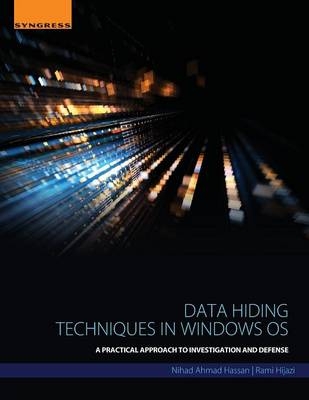
Data Hiding Techniques in Windows OS
Syngress Media,U.S. (Verlag)
978-0-12-804449-0 (ISBN)
Featured in Digital Forensics Magazine, February 2017
In the digital world, the need to protect online communications increase as the technology behind it evolves. There are many techniques currently available to encrypt and secure our communication channels. Data hiding techniques can take data confidentiality to a new level as we can hide our secret messages in ordinary, honest-looking data files.
Steganography is the science of hiding data. It has several categorizations, and each type has its own techniques in hiding. Steganography has played a vital role in secret communication during wars since the dawn of history. In recent days, few computer users successfully manage to exploit their Windows® machine to conceal their private data.
Businesses also have deep concerns about misusing data hiding techniques. Many employers are amazed at how easily their valuable information can get out of their company walls. In many legal cases a disgruntled employee would successfully steal company private data despite all security measures implemented using simple digital hiding techniques.
Human right activists who live in countries controlled by oppressive regimes need ways to smuggle their online communications without attracting surveillance monitoring systems, continuously scan in/out internet traffic for interesting keywords and other artifacts. The same applies to journalists and whistleblowers all over the world.
Computer forensic investigators, law enforcements officers, intelligence services and IT security professionals need a guide to tell them where criminals can conceal their data in Windows® OS & multimedia files and how they can discover concealed data quickly and retrieve it in a forensic way.
Data Hiding Techniques in Windows OS is a response to all these concerns. Data hiding topics are usually approached in most books using an academic method, with long math equations about how each hiding technique algorithm works behind the scene, and are usually targeted at people who work in the academic arenas. This book teaches professionals and end users alike how they can hide their data and discover the hidden ones using a variety of ways under the most commonly used operating system on earth, Windows®.
This is your hands-on guide to understand, detect and use today’s most popular techniques in hiding and exploring hidden data under Windows® machines, covering all Windows® versions from XP till Windows® 10. Starting with the Roman Emperor, Julius Caesar, and his simple cipher method to the surveillance programs deployed by NSA, to monitor communication and online traffic, this book will teach you everything you need to know to protect your digital data using steganographic & anonymity cryptographic techniques. Written in a simple style and requiring only basic knowledge of main Windows® functions, techniques are presented in a way to easily implement them directly on your computer.
Nihad A. Hassan is an independent computer security & forensic consultant. He has been actively conducting research on computer forensic techniques for more than 8 years. Nihad focuses on the subject of computer forensics and anti-forensic techniques in Windows® OS, especially the digital steganography techniques. Nihad has completed numerous technical security consulting engagements involving security architectures, penetration testing, Windows® OS diagnostic reviews, disaster recovery planning and computer crime investigation.He has written thousands of pages of technical documentation for different global companies in the IT and cybersecurity fields in both languages, Arabic & English. His writing style highlights the fact that information is simplified and is presented it in an easy manner, which gives him a wide reputation in this field. Nihad believes that security concerns are best addressed by well-prepared and security-savvy individuals. He also enjoys being involved in security training, education, motivation. His current work is focused on network security, penetration testing, computer forensic, anti-forensics techniques and web security assessment. Nihad has a BSc honors degree in computer science from the University of Greenwich in the UK.You can reach Nihad through:InfoSecurity blog: http://www.DarknessGate.com Personal website: http://www.ThunderWeaver.com Email: nihadhas@gmail.com Rami Hijazi is the General Manager of MERICLER Inc., an education and corporate training firm in Toronto, Canada. Rami is an experienced IT professional who lectures on a wide array of topics, including Object-Oriented Programming, Java, eCommerce, Agile development, database design, and data handling analysis. Rami also works as consultant to Cyber Boundaries Inc., where he is involved in the design of encryption systems and wireless networks, intrusion detection and data breach tracking, as well as planning and development advice for IT departments concerning contingency planning.
1. Introduction and Historical Background 2. Data Hiding Using Simple Methods 3. Data Hiding Using Steganographic Techniques 4. Data Hiding Under Windows® OS File Structure 5. Data Hiding Using Encryption Techniques 6. Data Hiding Forensics 7. Anti-Forensic Techniques 8. Future Trends
| Erscheinungsdatum | 04.10.2016 |
|---|---|
| Verlagsort | Rockland, MA |
| Sprache | englisch |
| Maße | 216 x 276 mm |
| Gewicht | 880 g |
| Themenwelt | Informatik ► Betriebssysteme / Server ► Windows |
| ISBN-10 | 0-12-804449-7 / 0128044497 |
| ISBN-13 | 978-0-12-804449-0 / 9780128044490 |
| Zustand | Neuware |
| Haben Sie eine Frage zum Produkt? |
aus dem Bereich


